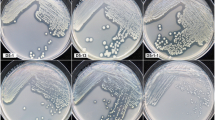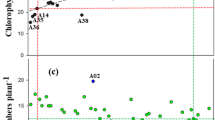Abstract
Currently, it is presumed that Escherichia coli is not a normal inhabitant of the soil. Soilborne E. coli strains were isolated from broad range of 7 geoclimatic zones of India, indicating that E. coli can survive and thrive under different extreme soil conditions. Diversity among E. coli strains from widely separated geographic regions using enterobacterial repetitive intergenic consensus (ERIC)-PCR did not reveal any relationships between the genotypes and the source of isolation. Inoculation of maize (Zea mays cv. Arkil) seeds with E. coli NBRIAR3 (NBRIAR3) significantly enhanced (P < 0.05) plant growth and nutrient uptake, when compared with uninoculated control. Presence or absence of NBRIAR3 did not affect significantly (P < 0.05) diversity indexes, using substrate utilization patterns on the Biolog Eco plates. Clone libraries based on 16S rRNA gene from rhizosphere of maize plants demonstrated rather similar phylotype diversity from the uninoculated control and NBRIAR3-treated rhizosphere soil, which further indicated that NBRIAR3 did not exert a major influence on the overall bacterial diversity. The methodological approach described in this study supports the idea that E. coli should be treated as native soil bacterium instead of as an “indicator” of the possible presence of other fecal coliform bacteria.




Similar content being viewed by others
References
Avery SM, Moore A, Hutchison ML (2004) Fate of Escherichia coli originating from livestock faeces deposited directly onto pasture. Lett Appl Microbiol 38:355–359
Brandl MT (2006) Fitness of human enteric pathogens on plants and implications for food safety. Annu Rev Phytopathol 44:367–392
Byappanahalli MN, Fujioka RS (1998) Evidence that tropical soil environment can support the growth of Escherichia coli. Water Sci Technol 38:171–174
Chao A (1984) Nonparametric estimation of the number of classes in a population. Scand J Stat 11:265–270
Chao A, Lee S-M (1992) Estimating the number of classes via sample coverage. J American Stat Asso 87:210–217
Compant S, Duffy B, Nowak J, Clément C, Barka EA (2005) Use of plant growth-promoting bacteria for biocontrol of plant diseases: principles, mechanisms of action, and future prospects. Appl Environ Microbiol 71:4951–4959
de Bruijn FJ (1992) Use of repetitive (repetitive extragenic palindromic and enterobacterial repetitive intergeneric consensus) sequence and the polymerase chain reaction to fingerprint the genome of Rhizobium mililoti isolates and other soil bacteria. Appl Environ Microbiol 58:2180–2187
Dohrmann AB, Tebbe CC (2006) Genetic profiling of bacterial communities from the rhizospheres of ozone damaged Malva sylvestris (Malvaceae). Euro J Soil Biol 42:191–199
Egamberdiyeva D (2007) The effect of plant growth promoting bacteria on growth and nutrient uptake of maize in two different soils. Appl Soil Ecol 36:184–189
Felsenstein J (1993) PHYLIP—phylogeny inference package (version 3.5c). Department of Genetics, University of Washington, Seattle
Fierer N, Bradford MA, Jackson RB (2007) Toward an ecological classification of soil bacteria. Ecology 88:1354–1364
Good IJ (1953) The population frequencies of species and the estimation of population parameters. Biometrica 40:237–264
Hong S-H, Bunge J, Jeon S-O, Epstein SS (2006) Predicting microbial species richness. Proc Nat Acad Sci 103:117–122
Hsu S-C, Tsen H-Y (2001) PCR primers designed from malic acid dehydrogenase gene and their use for detection of Escherichia coli in water and milk samples. Int J Food Microbiol 64:1–11
Ishii S, Ksoll WB, Hicks RE, Sadowsky MJ (2006) Presence and growth of naturalised Escherichia coli in temperate soils from Lake Superior watersheds. Appl Environ Microbiol 72:612–621
Jaccard P (1908) Nouvelles researches sur la distribution florale. Bull Soc Vaud Sci Nat 44:223–270
Kaiser O, Pühler A, Selbitschka W (2001) Phylogenetic analysis of microbial diversity in the rhizoplane of oilseed rape (Brassica napus cv. Westar) employing cultivation-dependent and cultivation-independent approaches. Microb Ecol 42:136–149
Kovach WL (1999) MVSP—a multivariate statistical package for windows, version 3.1. Kovach Computing Services, Pentraeth
Nautiyal CS (1997) Rhizosphere competence of Pseudomonas sp. NBRI9926 and Rhizobium sp. NBRI9513 involved in the suppression of chickpea (Cicer arietinum L.) pathogenic fungi. FEMS Microbiol Ecol 23:145–158
Nautiyal CS (2009) Self-purificatory Ganga water facilitates death of pathogenic Escherichia coli O157:H7. Curr Microbiol 58:25–29
Nautiyal CS, Dion P (1990) Characterization of opine utilizing microflora associated with samples of soil and plants. Appl Environ Microbiol 56:2576–2579
Nautiyal CS, Chauhan PS, Nene YL (2007) Medicinal smoke reduces airborne bacteria. J Ethnopharmacol 114:446–451
Nautiyal CS, Govindarajan R, Lavania M, Pushpangadan P (2008a) Novel mechanism of modulating natural antioxidants in functional foods: involvement of plant growth promoting rhizobacteria NRRL B-30488. J Agric Food Chem 56:4474–4481
Nautiyal CS, Srivastava S, Chauhan PS (2008b) Rhizosphere colonization: Molecular determinants from plant-microbe coexistence perspective. In: Nautiyal CS, Dion P (eds) Molecular mechanisms of plant, microbe coexistence. Soil biology series, vol 15. Springer, Berlin, pp 99–124
Oliver DM, Haygarth PM, Clegg CD, Heathwaite AL (2006) Differential E. coli die-off patterns associated with agricultural matrices. Environ Sci Technol 40:5710–5716
Olsen SR, Sommers LE (1982) Phosphorus. In: Page AL, Miller RH, Keeney DR (eds) Methods of soil analysis: part 2. SSSA, Madison, p 403
Page AL, Miller RH, Keeney DR (1982) Methods of soil analysis: part 2. Chemical and microbiological properties (2nd edn) agronomy, vol 9. ASA, SSSA Publishing, Madison, p 1159
Ram JL, Ritchie RP, Fang J, Gonzales FS, Selegean JP (2004) Sequence-based source tracking of Escherichia coli based on genetic diversity of β-glucuronidase. J Environ Qual 33:1024–1032
Schloss PD, Handelsman J (2005) Introducing DOTUR, a computer program for defining operational taxonomic units and estimating species richness. Appl Environ Microbiol 71:1501–1506
Schloss PD, Larget BR, Handelsman J (2004) Integration of microbial ecology and statistics: a test to compare gene libraries. Appl Environ Microbiol 70:5485–5492
Semenov AV, Franz E, van Overbeek L, Termorshuizen AJ, van Bruggen AHC (2008) Estimating the stability of Escherichia coli O157:H7 survival in manure-amended soils with different management histories. Environ Microbiol 10:1450–1459
Singleton DR, Furlong MA, Rathbun SL, Whitman WB (2001) Quantitative comparisons of 16S rRNA gene sequence libraries from environmental samples. Appl Environ Microbiol 67:4374–4376
Teske A, Hinrichs KU, Edgcomb V, Gomez ADV, Kysela D, Sylva SP, Sogin ML, Jannasch HW (2002) Microbial diversity of hydrothermal sediments in the Guaymas Basin: evidence for anaerobic methanotrophic communities. Appl Environ Microbiol 68:1994–2007
Villadas P, Fernández-López M, Ramírez-Saad H, Toro N (2007) Rhizosphere-bacterial community in Eperua falcata (Caesalpiniaceae) a putative nitrogen-fixing tree from French Guiana rainforest. Microbial Ecol 53:317–327
Williams AP, Avery LM, Killhamand K, Jones DL (2007) Survival of Escherichia coli O157:H7 in the rhizosphere of maize grown in waste-amended soil. J Appl Microbiol 102:319–326
Acknowledgments
Thanks are due to the Director, NBRI, for providing necessary facilities. We are grateful to unknown reviewers for their very constructive and helpful comments. The study was supported by Task Force grant NWP-006 from Council of Scientific and Industrial Research (CSIR), New Delhi, India.
Author information
Authors and Affiliations
Corresponding author
Additional information
Communicated by Joerg Overmann.
Electronic supplementary material
Rights and permissions
About this article
Cite this article
Nautiyal, C.S., Rehman, A. & Chauhan, P.S. Environmental Escherichia coli occur as natural plant growth-promoting soil bacterium. Arch Microbiol 192, 185–193 (2010). https://doi.org/10.1007/s00203-010-0544-1
Received:
Revised:
Accepted:
Published:
Issue Date:
DOI: https://doi.org/10.1007/s00203-010-0544-1




